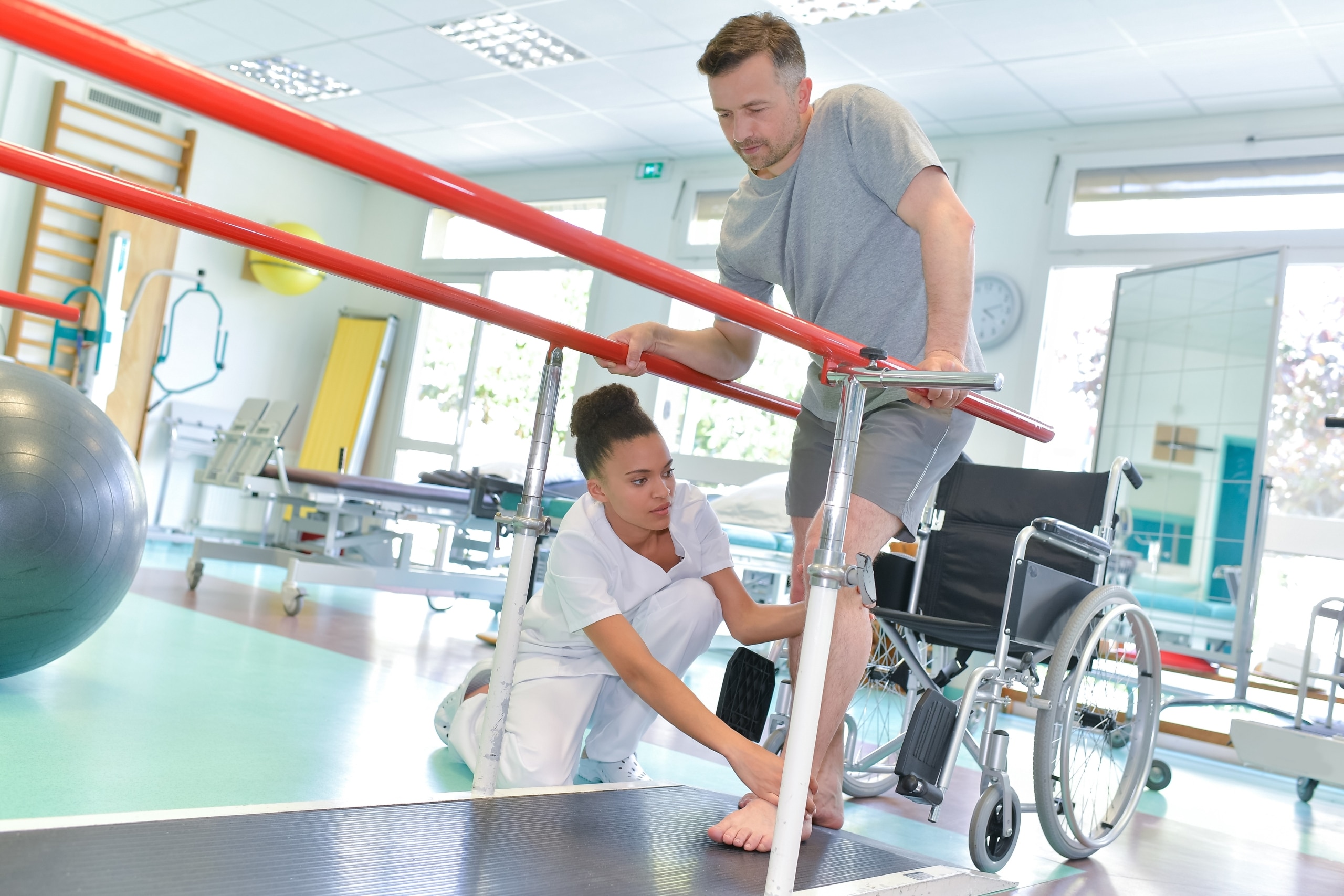How to Become an Acute Care Physical Therapist Assistant
Educational Requirements, Certifications, Daily Responsibilities, and Salary

When people are admitted to a hospital with serious injuries or illnesses, physical activity may be the furthest thing from their minds. However, in many cases, returning to some level of activity as quickly as possible without compromising safety can have significant benefits. As an acute care physical therapist assistant (PTA), you’ll get patients started on their recovery journey after a challenging time and earn a great living while doing so. We recently featured acute care physical therapist assistants on our top PTA jobs list.
This career guide will give you all the details about how to become an acute care physical therapist assistant. We’ll cover the required schooling, certifications, and what to expect from most days on the job. You’ll also learn how much you could make as an acute care PTA and how long it usually takes to launch your new career.
Are you interested in becoming a PTA but need to know if acute care is the right setting for you? Explore the other options on our list of the top physical therapist assistant careers.
Acute Care Physical Therapist Assistant Definition
What Is an Acute Care Physical Therapist Assistant?
Acute care physical therapist assistants provide rehabilitative care to patients as they recover from major surgeries, infections, or other severe conditions like cancer, strokes, or traumatic brain injuries. Acute care PTAs guide patients still in the hospital through the earliest stages of their return to physical activity.
Acute Care Physical Therapist Assistant: Job Description
What Does an Acute Care Physical Therapist Assistant Do?
Acute care physical therapist assistants help critically ill patients take the first steps in their recovery—sometimes literally. They help their patients build strength, balance, and mobility without overexerting themselves too soon. Acute care PTAs also commonly teach patients how to safely use medical equipment like walkers, wheelchairs, or canes to improve their mobility and prepare for a return to daily activities.
Acute Care Physical Therapist Assistant: Work Environment
Where Do Acute Care Physical Therapist Assistants Work?
Acute care physical therapist assistants work almost exclusively in hospitals or critical-care clinics. Because they treat are there for medium- to long-term hospital stays, acute care PTAs sometimes work with patients directly in their rooms or the surrounding hallways. They also commonly work in dedicated physical therapy facilities located within hospitals.
Acute Care Physical Therapist Assistant Duties
Some of the day-to-day responsibilities of acute care physical therapist assistants include:
- Measuring patients’ progress and recording their status
- Guiding patients through rehabilitative exercises as prescribed by a supervising PT
- Providing hands-on treatment like stretching, massage, or assisted mobility exercises
- Teaching patients how to use adaptive or assistive medical equipment like walkers or wheelchairs
- Educating patients and their caregivers about what to expect during their recovery
Other physical therapist assistant duties may include preparing and maintaining equipment and light administrative work like scheduling appointments or responding to emails.
Acute Care Physical Therapist Assistant Hours & Schedule
While most acute care PTAs work full-time, 40-hour workweeks, some hospitals, and clinics also offer part-time jobs. Because they’re employed by facilities caring for critically ill patients, acute care physical therapist assistants may work shifts outside of standard business hours. It’s rare for PTAs to work later than 8 or 9 pm, though weekend or holiday shifts may occasionally be required.

What Skills Do You Need to Become an Acute Care Physical Therapist Assistant?
To thrive as an acute care physical therapist assistant, you’ll need to be a caring and compassionate person with a healthy dose of emotional resilience. Some of your patients may never be the same after their medical issues, which can be challenging for them and their care providers. Physical strength and stamina are also crucial for acute care PTAs. You’ll be doing a lot of standing, squatting, and lifting while treating patients with severely limited mobility.
Why is Acute Care a Great Career Path for Physical Therapist Assistants?
Treating patients in the earliest stages of their recovery means you’ll witness significant breakthroughs for the people under your care. Seeing somebody stand or walk under their own power for the first time is immensely satisfying, thanks largely to your efforts as an acute care PTA. You’ll also work with patients of all ages and with various medical conditions, meaning you’ll never have to worry about your job becoming boring or monotonous.
Acute Care Physical Therapist Assistant Schooling, Training, & Certifications
What Degree Do You Need to be an Acute Care Physical Therapist Assistant?
To become an acute care PTA, you’ll need to complete a physical therapist assistant program from an accredited college or university. Most associate degree programs require two whole years in school, but by enrolling in an accelerated degree program, you could earn your PTA degree in as little as 21 months.
How Long Does It Take to Become an Acute Care Physical Therapist Assistant?
Like any other major accomplishment, the journey to becoming an acute care PTA feels more manageable when broken down into a series of smaller steps. People who work full-time jobs while taking PTA classes part-time may take longer to complete their degree than PTA students taking a full course load.
Our step-by-step guide breaks down what it takes to become an acute care physical therapist assistant:
1. Enroll in a Physical Therapist Assistant (PTA) Degree Program
The first step toward becoming an acute care physical therapist assistant is enrolling in a PTA program at an accredited college or university. PTA careers aren’t just for former honor-roll students—they’re for anyone willing to do the work necessary to further their education.
To qualify for the PTA degree program at Provo College, you’ll need a high school diploma or GED, a passing score on the Test of Essential Academic Skills (TEAS) exam, and a reliable Internet connection. Some PTA programs may also require completing background checks or drug screenings.
2. Earn Your Physical Therapist Assistant Associates Degree
Like any associates degree program, your physical therapist assistant education will include general-education requirements like math, English, science, and psychology. These courses will build your communication, critical thinking, and overall people skills to prepare you to work with acutely ill patients from all walks of life.
The bulk of your PTA degree program will focus on the specific skills and knowledge you need to excel as an acute care physical therapist assistant. Coursework includes building a deep understanding of the human body and how it moves, plus how to provide therapy to all types of patients with wide-ranging medical conditions. You’ll take courses covering kinesiology, pharmacology, and orthopedics and learn about the diseases and disabilities your severely ill patients are likely to have experienced. You’ll also participate in plenty of hands-on training to teach you how to provide safe, effective care to vulnerable patients.
During the final stage of your physical therapist assistant education, you’ll perform supervised therapy work with actual patients in a controlled clinical setting. Acute care PTAs must be extremely mindful not to push their patients too hard, which is knowledge gained only from time spent working under the guidance of an experienced physical therapist.
When deciding where to attend school for your physical therapist assistant degree, consider colleges offering additional benefits like career counseling and job-placement services. Getting your PTA education from an institution that has your back while you’re gearing up to start a new career can be a serious stress reliever.

3. Pass the National Physical Therapy Exam
Before earning your PTA license and starting work as an acute care physical therapist assistant, you’ll need to pass the PTA version of the National Physical Therapy Exam (NPTE). Passing this exam helps prove you can provide safe and effective patient care. The exam is a multiple-choice test with around 200 questions. You’ll have approximately four hours to complete the exam.
If you get anxious about taking tests, practice exams can greatly help. You can find practice exams through the Federation of State Boards of Physical Therapy (the same organization that administers the NPTE). The Practice Exam and Assessment Tool—or PEAT for short—will give you an idea of what to expect during the exam. You’ll also receive real-time feedback, which can help determine any topics requiring extra study time.
Not everyone passes the NPTE on their first attempt, including many people who eventually become successful PTAs. You can retake the exam if you come up short of the required passing score on your first try. However, be advised that you can only take the test up to three times in any given 12-month period. Be sure to give your NPTE exam prep the attention it deserves.
4. Get Your PTA License on a State-By-State Basis
Once you’ve passed the NPTE, you’ll be eligible to become licensed in the state(s) where you plan to work. Because the NPTE is a national exam, transferring your scores and gaining licensure in different states is usually simple. This gives you the flexibility to start your acute care PTA career just about anywhere. The Federation of State Boards of Physical Therapy will be your go-to resource for determining each state’s licensing requirements for PTAs.
Different states have varying requirements for maintaining your PTA license. However, most states will require occasional completion of ongoing education programs or proof of current employment and relevant work experience.
5. Gain Work Experience and Earn Additional Certifications
Before becoming an acute care physical therapist assistant, you’ll likely need to build some work experience in other physical therapy clinics. Acute care PTAs work with patients who are particularly vulnerable and require special considerations during treatment. Most hospitals and clinics look for PTAs with solid work experience before trusting them with critically ill patients.
For acute care physical therapist assistants who want to reach the top of their field, certifications from organizations like The American Physical Therapy Association are a great way to stand out. The APTA offers advanced training in acute care physical therapy, where you’ll level up your PTA skills and expand your knowledge of caring for patients recovering from serious medical issues. Plus, earning advanced certifications can help unlock some of the highest-paying PTA jobs.
How Much Does it Cost to Become an Acute Care Physical Therapist Assistant?
The cost of earning a physical therapist assistant associate’s degree varies significantly between institutions and according to your financial situation. When comparing the cost of college, be sure to ask how much you can expect to spend on lab fees, books, and other materials. Some colleges will include all these as part of a flat-rate pricing structure per credit hour, saving you money in the long run.
Wherever you’re pursuing your PTA education, you should inquire about financial aid programs that can make college significantly more affordable. At most colleges, the office of financial assistance can help you fill out the Free Application for Federal Student Aid (FAFSA), which determines your eligibility for federal and state grants, plus loans and institutional aid.

Acute Care Physical Therapist Assistant Salary
How Much Do Acute Care Physical Therapist Assistants Make?
Physical therapist assistants throughout the United States earn an average annual salary* of around $61,000, which is about $29.00 per hour. PTA salaries among the 25% of earners start at over $75,000. The highest-paid PTAs with salaries in the top 10% routinely bring in $80,000 per year or more.
While the U.S. Bureau of Labor Statistics doesn’t provide salary* data specifically for acute care physical therapist assistants, acute care PTA jobs tend to pay quite well, especially for candidates with years of experience and advanced certifications. After all, most hospitals want to hire the best PTAs to help care for their critically ill patients.
Ready to Start Your Career as an Acute Care Physical Therapist Assistant?
If you’re excited about looking after patients who are just beginning their journey back to recovery and independence, becoming an acute care physical therapist assistant could be your career calling. You’ll get to care for all types of patients and experience the satisfaction of watching previously bedridden people become healthy enough to be discharged from the hospital.
Learn more about the physical therapist assistant program at Provo College, and get started on the road to an exciting and fulfilling new PTA career today!
